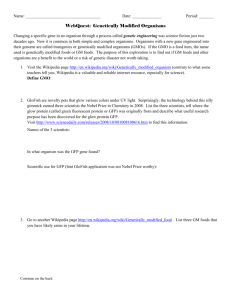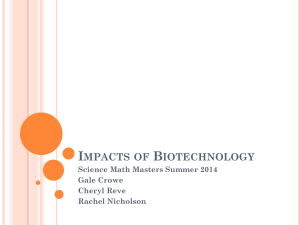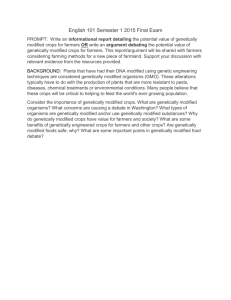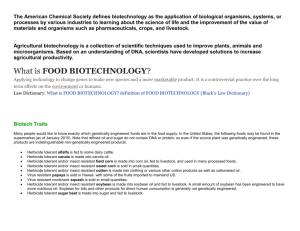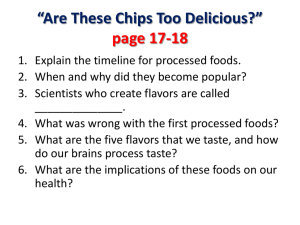File - Hannah Magill
advertisement
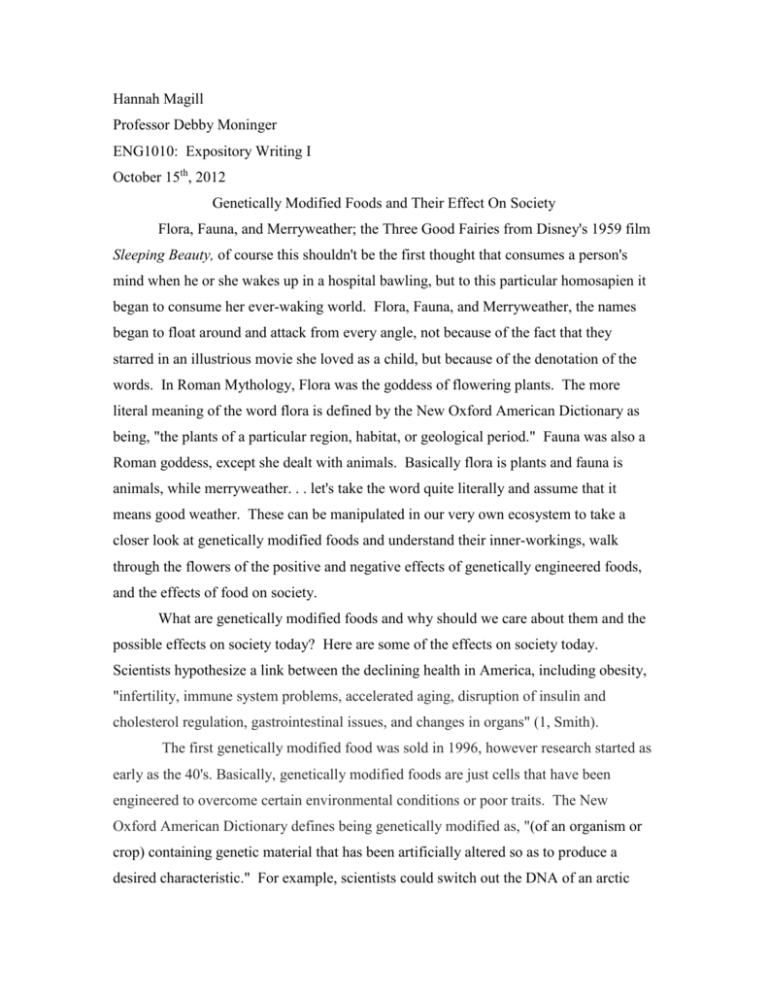
Hannah Magill Professor Debby Moninger ENG1010: Expository Writing I October 15th, 2012 Genetically Modified Foods and Their Effect On Society Flora, Fauna, and Merryweather; the Three Good Fairies from Disney's 1959 film Sleeping Beauty, of course this shouldn't be the first thought that consumes a person's mind when he or she wakes up in a hospital bawling, but to this particular homosapien it began to consume her ever-waking world. Flora, Fauna, and Merryweather, the names began to float around and attack from every angle, not because of the fact that they starred in an illustrious movie she loved as a child, but because of the denotation of the words. In Roman Mythology, Flora was the goddess of flowering plants. The more literal meaning of the word flora is defined by the New Oxford American Dictionary as being, "the plants of a particular region, habitat, or geological period." Fauna was also a Roman goddess, except she dealt with animals. Basically flora is plants and fauna is animals, while merryweather. . . let's take the word quite literally and assume that it means good weather. These can be manipulated in our very own ecosystem to take a closer look at genetically modified foods and understand their inner-workings, walk through the flowers of the positive and negative effects of genetically engineered foods, and the effects of food on society. What are genetically modified foods and why should we care about them and the possible effects on society today? Here are some of the effects on society today. Scientists hypothesize a link between the declining health in America, including obesity, "infertility, immune system problems, accelerated aging, disruption of insulin and cholesterol regulation, gastrointestinal issues, and changes in organs" (1, Smith). The first genetically modified food was sold in 1996, however research started as early as the 40's. Basically, genetically modified foods are just cells that have been engineered to overcome certain environmental conditions or poor traits. The New Oxford American Dictionary defines being genetically modified as, "(of an organism or crop) containing genetic material that has been artificially altered so as to produce a desired characteristic." For example, scientists could switch out the DNA of an arctic flounder and put it inside that of a tomato DNA because arctic flounders can withstand extreme temperatures in the cold and tomatoes can't. "It is a cell invasion process. The only way you can put the flounder gene into the tomato cell is to invade it and insert the gene" (What is Genetically Modified Food?). The way the scientists do this is by using bacteria and viruses. The desired DNA sequence is cut off a strand and put into gaps of E. Coli DNA. Scientists have to force the issue and cover it in bacteria filled soil that causes tumors in plants so the plant will accept the DNA. The E. Coli and desired DNA combine in this bacteria infested environment and are then inserted into the plant where the trait makes for a more resistant tomato to cold temperatures. This is not the only way they can manipulate the variations in these plants and their DNA. There is also a process where they electrocute the platelet cells so they are susceptible to DNA and a gene gun method which blasts particles of gold covered with the DNA into the plant cells. Of course, these cells have to be activated and need a promoter gene which is the cauliflower mosaic virus. Coincidentally, that is a lot of viruses, which should spark concern. Even though the process causes so much concern well go over the positive effects of genetically modified foods. World hunger is a serious problem and now biologists can genetically engineer plants to become more pestilent resilient and survive serious environmental problems like droughts or soils that contain too much or too little salinity. These techniques make plants more readily available in countries where they have serious environmental issues. An example, would be in third world countries that do not have the tools or technology other countries have. Secondly, the world has about 6 billion people in the world and one of the advantages of DNA modified foods is that they do produce more food than regular crops. These plants grow faster, reproduce more quickly, withstand insect infestations, grow in harsher conditions, and can grow about anywhere. Another benefit that has brought $27 billion to farmers has been the ability to put vaccines into bananas. Although there are positive effects, unfortunately, they are not being very wellproven today. In some third-world countries they have burned the genetically modified foods and refuse to grow it on their farms, because farmers have found their bodies weakening, cancer forming, bones being easily broken, terrible digestion problems after the plants moved in, and etc. There was also a study conducted showing genetically modified food yielding less food instead of more food. Struggling nations are not the only ones with concerns. There is research in the negative effects of biogenetically enhanced foods and why society is so immersed in its outcomes. First, people are afraid that plants are losing the diversity within the genes and if a serious virus came along it would wipe out the entire ecosystem. There may also be less round-up, but it is creating weeds that are resilient to pesticides. The bacillus thuringiensis, which is the pesticide they have inserted into corn is killing insect larvae like monarch butterflies indiscriminately. Not only that, Monsanto which is the number 1 seed company in the world is a classic example of GMOs gone wrong. Jerry Rosman, a seed dealer and pig farmer had reproductive problems with his pigs. It wasn’t some of them, it was 80 percent that were going through a fake birth, meaning these pigs would go through the symptoms of being pregnant, but once their due dates came they would either re-absorb the babies, or fluids back into their system or birth a sack of fluid. Mr. Rosman tried to challenge Monsanto and they buried him in paperwork and bullied him. He lost his farm and now tries to prove how bad their corn products are for animals. He subsequently has fed Monsanto feed to his cattle and made them sterile as well and then removed the feed and fed his cattle on a different feed from Monsanto and his cattle have become fertile again. The concerns do not end here. There is also the transfer of antibiotic resistance markers, fear of world domination by few seed companies, dependence on industrialized nations, violation of natural organisms intrinsic value, the horizontal gene flow, and not even to mention the detrimental health complications that arise around, or after eating these foods. In our ecosystem, if it is effecting the cattle and the pigs as Mr. Rosman has shown us how it is effecting the human realm? Which brings me to my final point, if cattle and pigs are being affected by these genetically modified foods, what is it doing to our bodies in the human realm? What if we could hypothesize a link between the declining health in America, including obesity, autism, crohn’s, ulcerative colitis, diverticulitis, celiac disease, cystic fibrosis, allergies, cancer, and chronic diarrhea? What are companies putting into our food that is giving us an expanding wasteline, larger than our ancestors 100 years ago! They were eating foods higher in fat, living longer then us, and not aging as quickly. How could they maintain a high in fat diet while “20-29 year-old-women maintained an average weight of 128 pounds. By 2000, the average weight for a 20-29 year-old-woman was 157 pounds.” (Women’s) Hopefully after looking at the inner-workings of GMOs, the positive and negative effects of genetically engineered foods, and the effects of food on society today. Although it may be argued that genetically modified foods may produce good things, the hazards far outweigh the good. Smith, Melissa Diane "Gmo Reality Check." Better Nutrition 74.8 (2012): 36-39. OmniFile Full Text Select (H.W. Wilson). Web. 9 Oct. 2012. "What Is Genetically Modified Food?" Video blog post. Http://www.youtube.com/watch?feature=player_embedded&v=jAP6ZtfP9ZQ#! AbbyMediaRoots, 16 Dec. 2009. Web. 1 Nov. 2012 "The Benefits of Genetically Modified Food Crops." Suite101.com. N.p., n.d. Web. 05 Nov. 2012. <http://suite101.com/article/the-benefits-of-genetically-modifiedfood-crops-a218670>. "Women’s Average Body Weight Increases 29lbs since 1960 « Stay Active and Live Life Fully." Womenn’s Average Body Weight Increases 29lbs since 1960 « Stay Active and Live Life Fully. N.p., n.d. Web. 05 Nov. 2012. "When Did Genetically Modified Food Start?" WikiAnswers. Answers, n.d. Web. 05 Nov. 2012. <http://wiki.answers.com/Q/When_did_genetically_modified_food_start> http://wiki.answers.com/Q/When_did_genetically_modified_food_start
